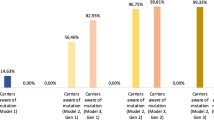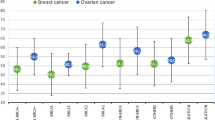Abstract
Inherited mutations of the BRCA1/2 genes confer a significantly increased risk for breast and/or ovarian cancer development. Several models were elaborated to help genetic counsellors in selecting individuals with high probability of being mutation carriers. The IC software, a country-customized version of the Brcapro model, was recently shown to be particularly accurate in the prediction of carrier probability status in the Italian population. Here, we used our independent series of 70 breast/ovarian cancer families to analyze the performances of the IC software and compare it to widely used models, such as Brcapro and the Myriad mutation prevalence tables. Analysis of the areas under the receiver operator characteristics (ROC) curves indicated that overall the models performed well. However, the IC software and Myriad tables were more efficient in predicting mutated cases, showing a higher sensitivity (94 and 88%, respectively) and negative predictive value (NPV, 94 and 92%, respectively) compared to Brcapro (sensitivity 71 and NPV 83%). IC software also appeared particularly accurate in the identification of families belonging the low mutation risk group (<10%). Finally, most Brcapro failures occurred in the hereditary breast cancer (HBC) family subset, and in 75% of the cases, the IC software corrected them. Our data suggest that the country-customized implementation operated on the Brcapro software generated a more accurate tool for the prediction of BRCA1/2 gene mutation. Whether the IC or other country-customized models might improve BRCA1/2 mutation prediction also in non-Italian families needs to be further explored.
Similar content being viewed by others
Log in or create a free account to read this content
Gain free access to this article, as well as selected content from this journal and more on nature.com
or
References
Martin AM, Blackwood MA, Antin-Ozerkis D et al: Germline mutations in BRCA1 and BRCA2 in breast-ovarian families from a breast cancer risk evaluation clinic. J Clin Oncol 2001; 19: 2247–2253.
Nathanson KL, Wooster R, Weber BL : Breast cancer genetics: what we know and what we need. Nat Med 2001; 7: 552–556.
Easton DF, Ford D, Bishop DT : Breast and ovarian cancer incidence in BRCA1-mutation carriers. Breast Cancer Linkage Consortium. Am J Hum Genet 1995; 56: 265–271.
Narod SA, Ford D, Devilee P et al: An evaluation of genetic heterogeneity in 145 breast-ovarian cancer families. Breast Cancer Linkage Consortium. Am J Hum Genet 1995; 56: 254–264.
Antoniou A, Pharoah PD, Narod S et al: Average risks of breast and ovarian cancer associated with BRCA1 or BRCA2 mutations detected in case series unselected for family history: a combined analysis of 22 studies. Am J Hum Genet 2003; 72: 1117–1130.
Marroni F, Aretini P, D'Andrea E et al: Penetrances of breast and ovarian cancer in a large series of families tested for BRCA1/2 mutations. Eur J Hum Genet 2004; 12: 899–906.
Couch FJ, DeShano ML, Blackwood MA et al: BRCA1 mutations in women attending clinics that evaluate the risk of breast cancer. N Engl J Med 1997; 336: 1409–1415.
Shattuck-Eidens D, Oliphant A, McClure M et al: BRCA1 sequence analysis in women at high risk for susceptibility mutations. Risk factor analysis and implications for genetic testing. JAMA 1997; 278: 1242–1250.
Vahteristo P, Eerola H, Tamminen A, Blomqvist C, Nevanlinna H : A probability model for predicting BRCA1 and BRCA2 mutations in breast and breast–ovarian cancer families. Br J Cancer 2001; 84: 704–708.
de la Hoya M, Osorio A, Godino J et al: Association between BRCA1 and BRCA2 mutations and cancer phenotype in Spanish breast/ovarian cancer families: implications for genetic testing. Int J Cancer 2002; 97: 466–471.
Frank TS, Deffenbaugh AM, Reid JE et al: Clinical characteristics of individuals with germline mutations in BRCA1 and BRCA2: analysis of 10 000 individuals. J Clin Oncol 2002; 20: 1480–1490.
Berry DA, Iversen Jr ES, Gudbjartsson DF et al: BRCAPRO validation, sensitivity of genetic testing of BRCA1/BRCA2, and prevalence of other breast cancer susceptibility genes. J Clin Oncol 2002; 20: 2701–2712.
Parmigiani G, Berry D, Aguilar O : Determining carrier probabilities for breast cancer-susceptibility genes BRCA1 and BRCA2. Am J Hum Genet 1998; 62: 145–158.
Antoniou AC, Pharoah PP, Smith P, Easton DF : The BOADICEA model of genetic susceptibility to breast and ovarian cancer. Br J Cancer 2004; 91: 1580–1590.
Evans DG, Eccles DM, Rahman N et al: A new scoring system for the chances of identifying a BRCA1/2 mutation outperforms existing models including BRCAPRO. J Med Genet 2004; 41: 474–480.
Marroni F, Aretini P, D'Andrea E et al: Evaluation of widely used models for predicting BRCA1 and BRCA2 mutations. J Med Genet 2004; 41: 278–285.
Santarosa M, Viel A, Dolcetti R et al: Low incidence of BRCA1 mutations among Italian families with breast and ovarian cancer. Int J Cancer 1998; 78: 581–586.
Ottini L, D'Amico C, Noviello C et al: BRCA1 and BRCA2 mutations in central and southern Italian patients. Breast Cancer Res 2000; 2: 307–310.
Stuppia L, Di Fulvio P, Aceto G et al: BRCA1 and BRCA2 mutations in breast/ovarian cancer patients from central Italy. Hum Mutat 2003; 22: 178–179.
ASCO: Statement of the American Society of Clinical Oncology: genetic testing for cancer susceptibility, Adopted on February 20, 1996. J Clin Oncol 1996; 14: 1730–1736; discussion 1737–1740.
ASCO: American Society of Clinical Oncology policy statement update: genetic testing for cancer susceptibility. J Clin Oncol 2003; 21: 2397–2406.
DeLong ER, DeLong DM, Clarke-Pearson DL : Comparing the areas under two or more correlated receiver operating characteristic curves: a nonparametric approach. Biometrics 1988; 44: 837–845.
Euhus DM, Smith KC, Robinson L et al: Pretest prediction of BRCA1 or BRCA2 mutation by risk counselors and the computer model BRCAPRO. J Natl Cancer Inst 2002; 94: 844–851.
Acknowledgements
We are grateful to Dr S Presciuttini for providing the IC software and critical reading of the manuscript. This work was partially supported by grants from Associazione Italiana per la Ricerca sul Cancro, Ministry of Health, the National research Council (CNR), the Ministry of University and Research, the Pasteur Institute, and the Cenci-Bolognetti Foundation.
Author information
Authors and Affiliations
Corresponding author
Rights and permissions
About this article
Cite this article
Capalbo, C., Ricevuto, E., Vestri, A. et al. Improving the accuracy of BRCA1/2 mutation prediction: validation of the novel country-customized IC software. Eur J Hum Genet 14, 49–54 (2006). https://doi.org/10.1038/sj.ejhg.5201511
Received:
Revised:
Accepted:
Published:
Issue date:
DOI: https://doi.org/10.1038/sj.ejhg.5201511
Keywords
This article is cited by
-
The BRCAPRO 5.0 model is a useful tool in genetic counseling and clinical management of male breast cancer cases
European Journal of Human Genetics (2010)
-
Prevalence of BRCA1 and BRCA2 genomic rearrangements in a cohort of consecutive Italian breast and/or ovarian cancer families
Breast Cancer Research and Treatment (2007)
-
Novel BRCA1 and BRCA2 germline mutations and assessment of mutation spectrum and prevalence in Italian breast and/or ovarian cancer families
Breast Cancer Research and Treatment (2006)



